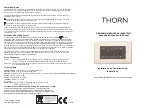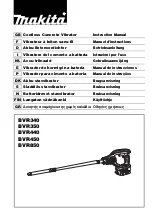
Operation
The system permits both signal chains to receive and demodulate a common signal coming from each antenna, and to make the
decision to switch based on:
•
A simple comparison of the lock/unlock status of the two demodulators
– if an antenna becomes blocked and its associated demod
loses signal acquisition, while the other signal chain remains in lock, then it can be correctly concluded that the system should
switch to the other antenna/signal chain) If both signal chains simultaneously report loss of acquisition (both antennas
simultaneously blocked, or in a severe rain fade), then no switch will occur.
•
A comparison of the signal quality reported by the two demodulators
– in this way, an Eb/No value can be defined that guarantees
a certain quality of service. If one antenna should become partially blocked, and the Eb/No falls below the defined threshold, then
the system will switch to the other signal chain.
•
Optionally, the state of externally supplied signals. The CDS-100 accepts signals (from an Antenna Control Unit, for example) that
will cause the system to switch from one signal chain to the other.
Note that the CDS-100 always mutes the Transmit IF output of the Modem that is not online. In this manner, only one of the RF
Terminals will be transmitting to the satellite at any given time.
Manual and Automatic Switchover
Manual switchover is carried out from the front panel or via the remote control capability of the online modem. Automatic switchover
conditions are user-defined by setting three switches at the front of the unit.
The user can select:
Unit Faults
only,
Unit Faults
or
Receive Traffic Faults
,
Unit Faults
or
Transmit Traffic Faults
,
Unit Faults
or
External Faults
, or any combination. The ability to define the conditions causing a switchover provides the CDS-100 user with a great
deal of operational flexibility.
Specifications
Operating Modes
Fully automatic switchover
Manual switchover (via the front panel
of the online modem, or via the
modem’s remote control interface)
Optional external fault inputs can be
used to control switchover
Architecture
TX clock and data signals fed to both
online and standby units (uses ‘Y’
cable for supported interface types)
Continuous fault comparison of online
and standby units
The configuration of online and
standby units is synchronized via the
Auxiliary Serial link between the two
modems
Switchover Time
Within 0.1 seconds (typical) after fault
detection
Fault Detection Time
0.5 seconds (maximum)
Control inputs
A and B modems connect via 9-pin D-
sub male connectors
External Fault inputs
A and B external faults connect via
9-pin D-sub female connectors
External Fault input
characteristics
For each A and B fault connector
there are three inputs:
2 inputs requiring, for fault activation:
5 volt CMOS logic ‘0’, or external relay
closure to ground
Or 1 input requiring, for fault
activation:
5
– 15 volt voltage
Unused inputs default to the non-
failed state, and all external faults are
logically ‘OR’ed together
Dimensions
(height x width x depth)
1.7” x 5.7” x 4.1”
(4.3 x 14.3 x 10.4 cm)
Weight
1.1 lbs (0.5 kg)
Power Requirements
+12 VDC @ 80 mA (max.)
– provided
by the two modems
Approval
CE
2114 West 7th Street, Tempe, Arizona 85281 USA
Voice: +1.480.333.2200
● Fax: +1.480.333.2540 ● Email: [email protected]
See all of Comtech EF Data’s Patents and Patents Pending at http://patents.comtechefdata.com
Comtech EF Data reserves the right to change specifications of products described in this document at any time without notice and without obligation to notify any person of such changes. Information
in this document may differ from that published in other Comtech EF Data documents. Refer to the website or contact Customer Service for the latest released product information
© 2018 Comtech EF Data
6/22/2018




















